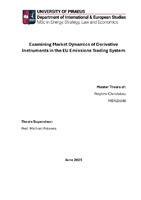Examining market dynamics of derivative instruments in the EU emissions trading system

Master Thesis
Συγγραφέας
Christakou, Polytimi
Χρηστάκου, Πολυτίμη
Ημερομηνία
2025-06Επιβλέπων
Polemis, MichaelΠολέμης, Μιχαήλ
Προβολή/
Λέξεις κλειδιά
EU ETS ; Derivatives ; Futures ; Machine learning ; RNN ; LSTM ; ARIMA ; GARCHΠερίληψη
The EU ETS is considered to be the cornerstone of the European Union's policy framework to combat climate change and serves as a key mechanism for reducing greenhouse gas (GHG) emissions in a cost-effective manner. Unlike traditional financial markets, the EU ETS constitutes an artificial market, established through regulatory intervention separated into timing periods (phases) and with determined supply of EUAs under each phase, therefore displaying unique characteristics.
This thesis aims to examine the market dynamics of exchange traded derivatives – futures – on the EU ETS, both quantitatively and qualitatively, via exploring potential forecasting power of futures returns as an explanatory variable for spot returns. To achieve this, both traditional statistical methods (ARIMA-X, GARCH) and machine learning techniques (RNN – LSTM) are applied, in order to assess and compare the predictive performance of the respective models. The analysis concludes that futures returns are strong explanatory variables for spot returns, with the ARIMAX model outperforming LSTM in terms of accuracy across multiple error metrics. However, this result is highly sensitive to the model parameters and assumptions employed.
To support this methodological analysis, the thesis begins with a comprehensive literature review and an overview of the EU ETS in the EU and global landscape, market structure, and relevant economic theories. A detailed examination of derivative instruments is included to help the reader comprehend the role of futures in emissions markets, particularly in terms of risk, speculation, and price formation.


